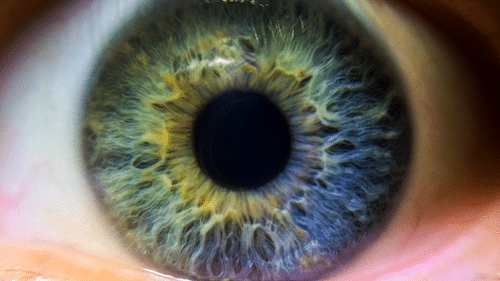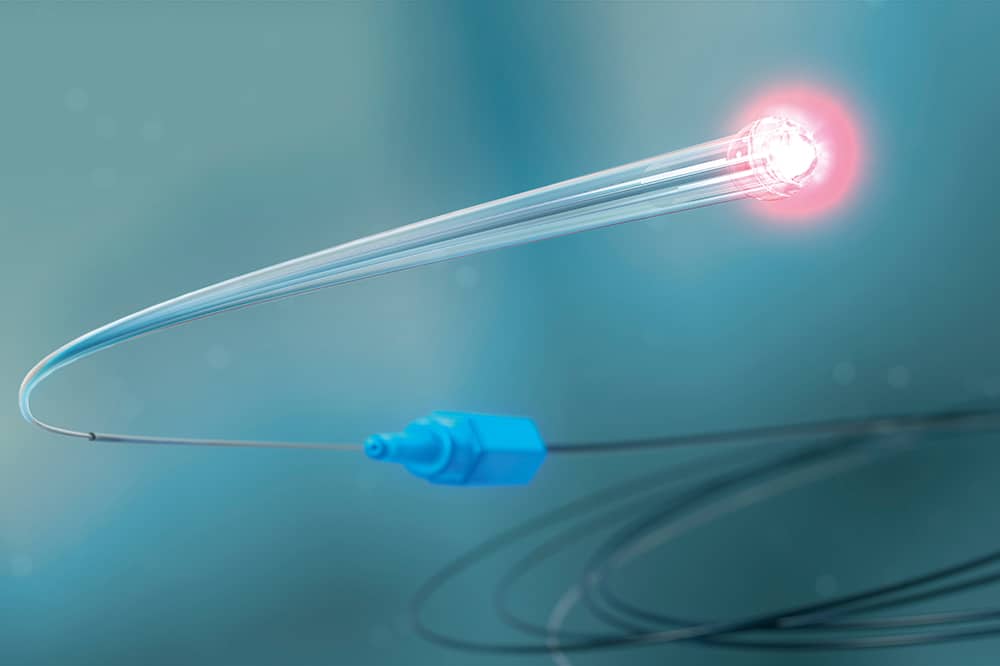
iTrack
A simple three-step procedure, iTrack is a minimally invasive glaucoma procedure that can reduce the elevated intraocular pressure associated with glaucoma.
learn moreLower eye pressure. Naturally.
Unlike other glaucoma treatments that bypass the eye's natural drainage channel, or act to mechanically change it, iTrack restores the eye's natural outflow pathways.

What causes glaucoma?
In the healthy eye, fluid constantly circulates to maintain the eye's shape and health. If the fluid does not drain at the same rate that it is produced, pressure will begin to build in the eye. Over time, this increased pressure can damage the optic nerve and cause vision loss if not treated.

How does iTrack work?
Based on the same principles as angioplasty, iTrack uses microcatheter technology to enlarge your eye’s natural drainage system, improving outflow and lowering intraocular pressure.

Take control of your glaucoma.
iTrack is an excellent fit for glaucoma patients who are frustrated with the level of effectiveness of their medications, but are not ready for traditional surgery.
iTrack can also free you from the financial and lifestyle burdens of glaucoma medications.
iTrack for glaucoma
iTrack acts to restore the eye’s natural outflow system and does not require a permanent implant or device in your eye.
iTrack uses micro-catheter technology to enlarge your eye’s natural drainage system, improving outflow and lowering eye pressure.

Dr Nathan Kerr
Melbourne Glaucoma and Cataract SurgeoniTrack
Advantages benefits- Restorative treatment of eye’s natural drainage system
- Sustained reduction of pressure in the eye
- Reduced dependence on expensive medications
- Minimally invasive for quicker recovery and return to daily activities
- Limited risk of complications versus traditional surgical alternatives
- No need for a permanent implant or device in your eye
- No limitations on your favourite activities
Who may benefit from iTrack?
It is necessary to first undergo an eye examination to determine if you are eligible for iTrack. iTrack is an effective surgical option for many glaucoma patients. If you fit into any of the following categories, you may be a candidate for iTrack:
Open-angle glaucoma
If you have primary open-angle, pseudoexfoliative, or pigmentary glaucoma.
Side effects from medication
If you are intolerant of glaucoma medications, or have difficulty taking them as prescribed.
Failed laser
If you have a history of failed laser trabeculoplasty.
Having cataract surgery
If you are about to have cataract surgery and wish to reduce the number of glaucoma medications you are currently taking.
Experienced iTrack surgeon
Dr Kerr is one of only a handful of surgeons in Australia trained to perform iTrack.
make an appointment
Frequently asked questions
Discover how iTrack could help treat your glaucoma.
What is iTrack?
The iTrack glaucoma surgery system is a minimally invasive procedure that can effectively reduce the elevated eye pressure associated with glaucoma. It can also reduce your reliance on anti-glaucoma medications.
How does iTrack work?
iTrack uses microcatheter technology to enlarge your eye’s natural drainage system, similar to angioplasty. iTrack works within the natural structures of the eye and no artificial pathways are created. It is also an implant-free procedure.
What happens during the procedure?
First, Dr Kerr will make a small incision in the eye. A microcatheter designed specifically for iTrack is then inserted into the eye’s circumferential drainage canal, which may be reduced in size or closed due to the high pressure in your eye. Your surgeon will advance the microcatheter 360 degrees around the canal to open up the channel and enlarge it. The microcatheter tip is slowly pulled back while sterile, gel is injected into the canal to dilate it to 2 – 3 times its normal size. Enlarging and flushing through the drainage canal and adjacent outflow channels helps the aqueous fluid to drain properly. The microcatheter is then withdrawn from the eye. It is important to note that there are no permanent implants or devices left in the eye.
What results can I expect with iTrack?
iTrack is clinically proven to significantly reduce intraocular pressure (IOP). As an added benefit, many patients who undergo iTrack no longer require anti-glaucoma medications, or can reduce the number of medications required.
You can resume normal, day-to-day activities, such as watching TV, immediately following treatment. After the surgery, you may feel some slight irritation under the eyelid until the sutures have fully resorbed. You may also see some bleeding in the front of the eye. This is usually a sign that the connection between the circulatory system and the aqueous outflow has been restored and that the surgery has been successful. Your surgeon will schedule one or more post-operative visits to ensure that everything is going smoothly and to check your IOP, and will prescribe drops to soothe your eye and prevent infection.
It is important to remember that managing glaucoma is a lifelong process; even after iTrack and other glaucoma treatments, you will need to continue to visit your ophthalmologist every 4 to 6 months.
How much does iTrack lower eye pressure?
iTrack is the only MIGS procedure that successfully addresses all aspects of potential outflow resistance, including the trabecular meshwork, Schlemm’s canal and the Collector Channel system. By addressing all aspects of outflow resistance iTrack is able to deliver an average reduction in eye pressure of 30%. It can also reduce your glaucoma medications by 50%.
What are the side effects of iTrack?
iTrack is a minimally invasive glaucoma surgery and offers a high safety profile with limited risk of complications and side effects. It is associated with significantly fewer risks, both in number and severity, than traditional glaucoma surgeries. It is important to note, however, that all surgeries have risks associated with them. The most common side effects associated with iTrack are bleeding in the eye and IOP spikes.
What is the difference between iTrack and trabeculectomy?
During trabeculectomy, your surgeon will create a hole in the wall of the eye (sclera) to allow the fluid to flow from the inside of the front of the eye (anterior chamber) through the scleral hole to a bleb (cyst, or blister-like elevation of the conjunctiva). Trabeculectomy is a highly invasive technique that bypasses the eye’s natural outflow pathways and carries a high risk of complications such as infection and leakage. In contrast, iTrack is a minimally invasive technique which uses breakthrough microcatheter technology to enlarge your eye’s natural drainage system, improving outflow and lowering eye pressure. It is important to note that iTrack acts to restore the natural outflow system, rather than bypass it. And iTrack does not leave any permanent implant or device in your eye.
How long has iTrack been performed?
iTrack is essentially a modification of a procedure called ‘viscocanalostomy’, which was first described in 1991 by South African glaucoma specialist Dr. Robert Stegmann. The iTrack microcatheter required to perform iTrack was approved by the FDA more than 10 years ago. To date, more than 60,000 procedures have been performed worldwide.
Does iTrack work for all types of glaucoma?
iTrack is an effective surgical option for the majority of glaucoma patients, including: open-angle glaucoma (OAG), pigmentary glaucoma (PG), pseudoexfoliation glaucoma (PXF), normal tension glaucoma (NTG) and juvenile glaucoma. It is also suitable for patients who wear contact lenses. Patients with contact lenses are unable to undergo the traditional forms of glaucoma surgery (trabeculectomy or shunt). iTrack is well suited to patients at high risk for infection or bleeding and those with enhanced wound healing. iTrack may also be suited to patients who have had complications in the other eye following trabeculectomy.
Who may benefit from iTrack?
It is necessary to first undergo an ophthalmic examination to determine your eligibility for iTrack. iTrack is an effective surgical option for the majority of glaucoma patients. If you fit into any of the following categories, you’re a good candidate for iTrack:
• If you have primary open-angle, pseudoexfoliation, or pigmentary glaucoma. (If you’re not sure, ask your ophthalmologist.)
• If you are intolerant of glaucoma medications, or have difficulty taking them as prescribed.
• If you are about to have cataract surgery and wish to use this opportunity to reduce the number of glaucoma medications you are currently taking.
• If it is difficult for you to commit to regular follow-up treatments, due to finances, lack of transportation, or other limitations.
• If you have a history of failed ALT (argon laser trabeculoplasty) treatments.
• iTrack is also suitable for patients who wear contact lenses. Patients with contact lenses are unable to undergo the traditional forms of glaucoma surgery (trabeculectomy or shunt).
• Please note that iTrack is not suitable for patients with neovascular or chronic angle-closure glaucoma.
What if iTrack doesn’t work for me?
A key benefit of iTrack is that is does not preclude other forms of glaucoma surgery. If the procedure is unsuccessful, your surgeon may elect to perform laser-based treatment, such as SLT, or conventional glaucoma surgery (trabeculectomy). Medication may also be an option.
If you liked this page, please share it on social media to let people with glaucoma know about iTrack.
Want to learn more about iTrack?
Read my article on minimally invasive glaucoma surgery
read nowPopular

